17th Century Hygiene Or The Many Smells Of Versailles…
The definition of cleanliness has changed over the centuries. Today we know about germs and how diseases can spread, we have things like antibacterial soaps and sprays, in some households there is both a shower and a bathtub and we have machines that do our laundry. If you think of the 17th Century in that perspective, you might be glad that you can not actually smell it. It stank and by our hygiene standards, it was really filthy….

When you think Versailles, you think of the grand golden palace and its vast gardens, but you do not necessarily think of filth. Yet it was a part of Versailles just like the Sun symbol. Thousands of people frequented the palace daily, up to five thousand when there was a fancy entertainment or reception, and a small army was needed to keep it at least somewhat clean. While the noble occupants of Versailles had to keep their own apartments clean, the public rooms and those of the Royal Family were cleaned by this small army. The public rooms during the nights and early mornings, the private rooms of the King and his family whenever they were empty. Servants collected plates and glasses, maids cleaned the furniture and mirrors, sweepers took care of the floors before the polishers arrived to make the parquet shine by polishing it with coloured wax.
Since Versailles was pretty much always a construction side, there was also all the dust and dirt caused by the construction work to take care of. While there was building work going on at one part of the chateau, others needed patching already. A place that is occupied by so many people shows signs of usage pretty quickly. Scratches on the floor, damaged tapestry and furniture, crumbling paint on the ceiling and those large wall paintings, windows that do not close proper, dirty chimneys, round corners, dust beneath the beds and on top of them, smelly curtains and dirty carpets….. to fix those and give the place a proper wiping, the whole palace needed to be cleared, because the longer the court stayed at one place, the dirtier it got. It was not a new problem and one reason why the court moved from residence to residence in the early 17th century. When the court moved, all furniture was taken with it, which gave those charged with the cleaning of the places the chance to finally give everything the proper wipe it needed so badly. As the court settled in Versailles, this was a bit of a problem. King and court hardly moved anymore, thus getting the whole place clean was a bit more difficult. Sometimes there was only a single chance during the whole year to give Versailles the basic cleaning, mostly when the court went to Fontainebleau.
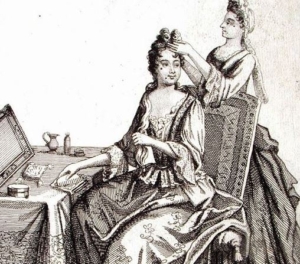
Dirt is not the only thing that collects when a place is heavily frequented, bad smells become a problem too. Versailles had a bit of a natural odour issue caused by the very land it was built on. The former march land had quite the foul smell at some spots, especially during the summer, which mingled with the scents of sweat given off by the courtiers and their garments.
Contrary to popular belief, people did actually bathe back then, but they did not do it as often as we do now. Bathing, especially in warm water, was considered bad for the health. As we know, warm water opens the pores of the skin and people were already aware of it back then. Since their water was mostly not as clean as ours is now, they thought that all the kinds of diseases could then, when the pores are opened, sneak into the body via the skin and bring possible death. Generally it was thought that running water was safer than standing water and that the longer water did not move, the more dangerous it became. Baths in rivers, properly dressed for the occasion of course, were quite common during the warm months, but actual baths in tubs a bit more sparse.
Not only because of the whole pore issue, but also because having a warm bath was a bit of a luxurious thing not everyone could afford. Clean water needed to be fetched, heated, and carried through endless corridors to be poured into a heavy tub made of metal laid out with linen, so the bather did not burn their behind on the hot metal, then the tub needed to be emptied again, while the bather, as it was recommended, held rest or napped for a while after the act of bathing. Soap was expensive and so were the scented oils that were poured into the water. All in all, it was quite the undertaking that required a lot of people to have it executed. Bathing was also something that was usually done in company and Louis XIV is the best example for it. Oui, he actually had more than three baths. The Sun King had a whole apartment built on the ground floor of Versailles for the purpose of bathing. It even had running water and its highlight was a large marble tub in which he spent many merry hours in company of Madame de Montespan. Several smaller tubs were also part of this apartment, in which Louis could bathe in company of a friend or two, before retiring into the vast enclosed resting room. Anne d’Autriche and Marie de’ Medici also had large marble tubs in which they bathed. Louis XIV’s grand tub was octagonal and made of a single block of marble. It can be entered by the means of four small steps and has two holes in it through which water could be pumped. Those holes are thought to have been covered by stylish golden dolphins. This monster of a tub still exists and is in possession of the chateau de Versailles. (If you watch the series Versailles, you have actually seen it. George wallows in it with a Nymph in the first episode.)
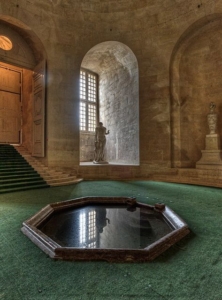
Bathing is quite the difficult topic. Some seem to have done it more frequently, others did not and the reasons for it are vast. Not only was it considered by most to be bad for the health and a bit of a luxury thing, it was also considered to be more of a sensual thing. Physicians could not quite agree whether it is good or bad either. Some were of the opinion that bathing was entirely unnecessary, while others recommended it in certain situations to improve the health. Bathing in cold water was never seen as particularly dangerous, if the water is running, and thus executed more often during the warm months. Here the physicians agreed that it improves the health and clears the mind.
Even-though people might not have had a weekly bath, does not mean they were filthy. By their own standards, they were rather clean…. most of them. When getting out of bed, washing ones hands and face was standard and a quick wash of the rest of the body followed in form of ‘rubbing’. Some used a wet cloth for this, some preferred to be rubbed down with perfumes, others used what was considered to be the safest, alcohol. Louis XIV in particular was rubbed down with cloths soaked in alcohol every day. (Louis did not like perfumes too much and preferred the alcohol wash. He once said to Madame de Montespan that perfumes give him a headache, but it might have been more of a personal thing then, since they were arguing in a closed carriage and by saying ‘your perfume gives me a headache’ he might have meant something slightly different…..)
This being rubbed down was part of the toilette, the act of getting up and dressed, which was, depending on the rank of the person, something that happened more or less in public. Like during the Lever of the King, a Princesse would get ready for the day while receiving many visitors. Just like today, some people were more fussy with their personal hygiene than others. While Louis XIV can be seen as someone who was fussy with it, the Princesse de Condé, wife of le Grand Condé, is said to have given off an odour from her armpits that was difficult to ignore.
This quick wash in the mornings was actually considered to be enough, because the thing what was thought to keep a person clean, was not necessarily washing and water. It was linen. Undergarments and bed-sheets were made of linen and it was thought that this fabric would absorb dirt and smells. Thus changing the sheets daily was a must, just as changing ones under garments. Louis XIV changed his linen shirt several times a day and so did most of the noblemen. It was not only just to stay clean, but also to show off ones wealth. The more often a man would change his shirt and the whiter those shirts were, the richer and the more attractive he was.
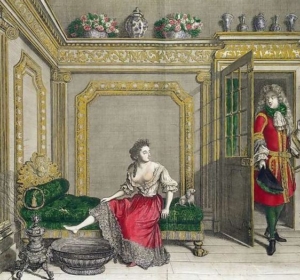
Good teeth were also considered attractive and to keep them in good shape, the 17th century courtier had different kinds of powders which were rubbed onto the teeth. Those powders could consist of basically everything, from crushed and dried herbs to powdered sage or even ash. The courtiers also had different kinds of mouthwashes at their disposal, some consisting of vinegar or wine, others honey and all sort of sweet things. To rub those powders on the teeth, the fingers could be used or small wooden devices wrapped in linen. All of it was, of course, not half as effective as the toothbrushes and toothpaste we have today and again, some were more fussy with it than others. As Louis XIV married Marie-Thérèse, her teeth were in quite the bad state already. She was very fond of chocolate and everything sweet. Today we know that sweet things are not really good for the teeth, back then they did not know that. Sugar was something only the rich could afford and to show off that they could afford it, it was added to most dishes and even to the powders that were supposed to keep the teeth clean. There was no such thing as dental care either and the mouth odour of most courtiers was most likely breathtaking even if they tried their best to keep their teeth clean.
Even-though a courtier could do everything in their power to stay clean, with baths, being rubbed down, cleaning their teeth, they could still smell awful due to the garments they wore. While the linen of the undergarments, chemises and shirts could be boiled and washed relatively easily, the fabrics that were worn above the undergarments could not be cleaned so easily. Depending on the rank and wealth of the courtier, they would either have a lot or just very little outfits to choose from. While Madame de Montespan had a vast choice of outfits, a lesser ranking lady would only have a handful, which she would alter with different kinds of shawls, lace, brooches or pearls. No matter if many or only few outfits were at hand, they were rather difficult to keep clean. Court outfits had to be made out of specific fabrics and especially the State Robes, those that were worn for the grand fetes or receptions, did cost more than some nobles earned in a year. Washing those fabrics was in some cases nearly impossible. Stains could be carefully rubbed out, but that was pretty much it. To freshen a State Robe up, it was hung in a breeze. If one has more than one of those, one Robe could enjoy the breeze, while a other was worn, but most of the lesser nobility only had one of them, because they were that expensive. Those outfits sparkling with gems were worn several times a year and when there was a grand fete even several days in a row. They did get rather smelly after a while. The issue was not just present with the State Robes, but also the outfits the courtiers would wear everyday. Although they were not proper outfits for the balls, they were still made of expensive fabrics that were adorned with gems here and there.
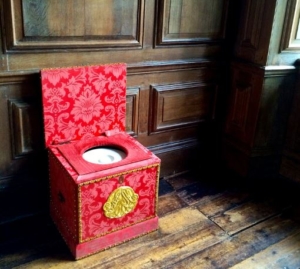
Another cause of bad smells were the cesspools. In their rooms, the courtiers had chamber pots, which they used for their daily business. The members of the Royal Family had a bit more comforts there. Their apartments included a small room, which was sometimes also used to store the linen or candles, in which a sort of toilet chair was placed. Those had a hole on the seat under which the chamber pot could be placed on the floor or fastened to the actual chair. On the floor plans, those rooms are discreetly called Gaderobes, but they were also known as Cabinets des Affaires. While today this sort of business is something done in private, the courtiers of Versailles were not that worried about their privacy in that department. Some received visitors while on the loo or placed themselves on it while in company. Louis XIV’s closest family was allowed to enter his Cabinet des Affaires and Versailles had about 274 of these toilet chairs during his reign. Doing the business was not the problem, getting rid of it was. The chamber pots had to be carried all the way through the chateau to the nearest and foul-smelling sewage pit. Since that was quite the hassle, the contains were often simply thrown out of the windows. To clean oneself up after the business was done, small pieces of cloth were used. Louis XIV had two servants that were charged with cleaning his pot and handing him the cloth. (A more proper toilet was installed under Louis XV, it even had a water flush.)
Versailles also had public toilets, but considering how many people were in need of those, it were far too few. Those public loos were installed below the public staircases in hopes that the ventilation caused by the passersby would keep the evil smells away. It did not work. Some of the public loos were in miserable conditions and others prone to spill over. If the latter was the case, the contains oozed into the walls and floors. That seemed to have happened quite often with one of the public loos, so often that those living in the apartments close-by fled their rooms and complained the mess soaked through the walls. The rooms close to the loos were obviously not much favoured. Voltaire once lodged close to one of the public loos, in which also the contents of the chamber pots were emptied, and described it as the ‘worst smelling shithole of all of Versailles‘. The pipes through which the waste was supposed to be transported away, got blocked often as well. One of those pipes went straight through the Cuisine de la Reine, where the meals for the Queen were prepared, and leaked all over the place. The catastrophic conditions of the public loos, got many people to simply do their business somewhere else in the palace, for example in the galleries. All of this did not just cause a terrible stench, but also all sorts of vermin.

To fight the bad smells caused by the courtiers, their garments and the leaking loos, perfume was used. Plenty of it. Liselotte von der Pfalz apparently used so much of it, that the Dauphine fainted several times due to it. Perfumes did not necessarily make things better. The already foul air mingled with the scents of different perfumes, some quite terrible smelling by themselves, and created an odour that was hard to endure. To fight this again, courtiers carried little richly embroidered bags with them that were filled with well-smelling herbs or flower petals. Vases with Potpourri were placed in the apartments and public rooms and their scents varied depending on the seasons. Herbs were also burned frequently to make the air better.
What did Versailles smell like? Like all the things above, plus stale water. Stale water from the many fountains and reservoirs, as well as from the emptying of tubs and basins on the small court yards. All in all, not too pleasant.
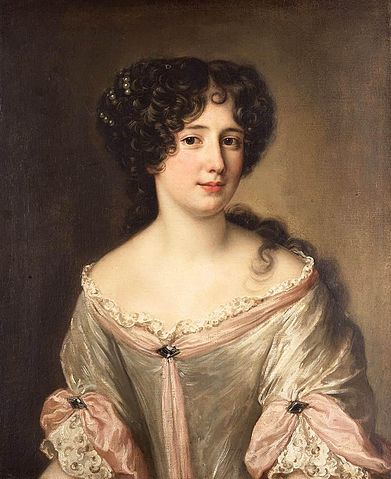


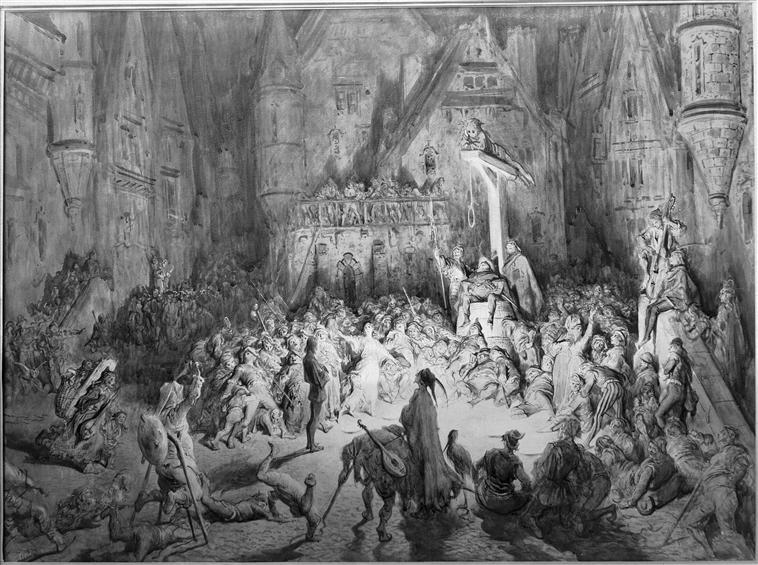

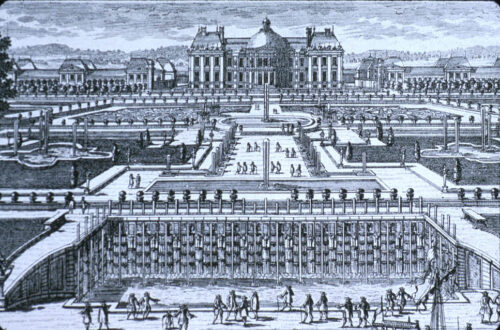
9 Comments
Blanche
Very interesting blog about Versailles you addressed all relevant points. Thankyou!!
Stew Ross
I ran across your blog and enjoyed it very much. We seem to have similar interests. I hope you can go to my blog site (stewross.com) and take a look at some of my blogs. The blogs try and tie into my books. You may be interested in them and if so, I’d be happy to send you one (perhaps Volume One of the Revolution book-there are several walks devoted to Versailles and its village). Also, perhaps you’d consider in writing a guest blog to post on my site. Anyway, let me know. Keep up the good work. STEW
AuroraVonG
Thank you for reading and I would love to. We should keep in touch 🙂
Julie De Angelis
I’ve read a bit on the subject of Versailles in general, mostly design and architecture as for the curious olefactory/hygiene end of things I like your writing the best??❤ The most disturbing for me is the thought of resorting to the emptying of chamber pots straight out the windows!
Ciel
I would not do well there.
Karen Lyons kalmenson
Very interesting and one can almost imagine themself in the very thick of it
Dimiter
Very entertaining! How did you found out those details? Did you read it in historic texts or you had to speculate about it?
Cheyenne Foxe
Thank you for this excellent petite histoire about the French court. I have always been fascinated by the beauty and finery of Versailles and the intrigues of the court a la “Dangerous Liasons”. Im a historian and professor of literature and so i love your exqiusite research and the importance of social history in viewing and understanding this epoch in French History. Oh Mon Dieu that must have smelled horrible with all the chamber pots, sweat, vermin and over indulgence! You bring such an intricate look to this period. Your books are excellent. The book on the Sun King was a masterpice. Also I have taught Moliere for years and didnt know he died during the “malade imaginaire.” Much appreciation, Dr. Cheyenne Asia Foxe.
Leigh Grieveson
In the excellent book ‘The Foul and the Fragrant’ by Alain Corbin he mentions an old lady, who had passed her youth at Versailles in it’s heady, dirty days. She recollected fondly that whenever she smelled urine and feaces it took her back to her salad days at court.